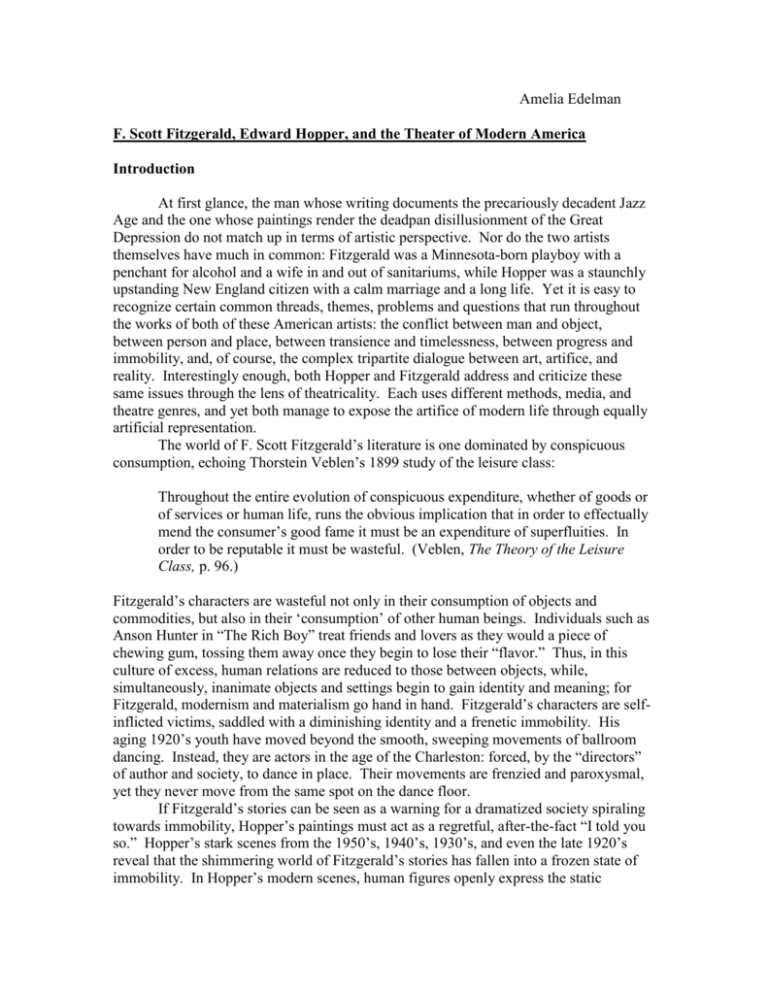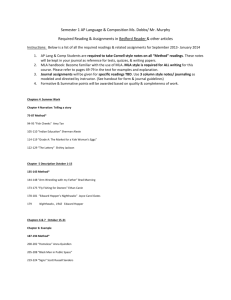Amelia Edelman - Evening Papers
advertisement

Amelia Edelman F. Scott Fitzgerald, Edward Hopper, and the Theater of Modern America Introduction At first glance, the man whose writing documents the precariously decadent Jazz Age and the one whose paintings render the deadpan disillusionment of the Great Depression do not match up in terms of artistic perspective. Nor do the two artists themselves have much in common: Fitzgerald was a Minnesota-born playboy with a penchant for alcohol and a wife in and out of sanitariums, while Hopper was a staunchly upstanding New England citizen with a calm marriage and a long life. Yet it is easy to recognize certain common threads, themes, problems and questions that run throughout the works of both of these American artists: the conflict between man and object, between person and place, between transience and timelessness, between progress and immobility, and, of course, the complex tripartite dialogue between art, artifice, and reality. Interestingly enough, both Hopper and Fitzgerald address and criticize these same issues through the lens of theatricality. Each uses different methods, media, and theatre genres, and yet both manage to expose the artifice of modern life through equally artificial representation. The world of F. Scott Fitzgerald’s literature is one dominated by conspicuous consumption, echoing Thorstein Veblen’s 1899 study of the leisure class: Throughout the entire evolution of conspicuous expenditure, whether of goods or of services or human life, runs the obvious implication that in order to effectually mend the consumer’s good fame it must be an expenditure of superfluities. In order to be reputable it must be wasteful. (Veblen, The Theory of the Leisure Class, p. 96.) Fitzgerald’s characters are wasteful not only in their consumption of objects and commodities, but also in their ‘consumption’ of other human beings. Individuals such as Anson Hunter in “The Rich Boy” treat friends and lovers as they would a piece of chewing gum, tossing them away once they begin to lose their “flavor.” Thus, in this culture of excess, human relations are reduced to those between objects, while, simultaneously, inanimate objects and settings begin to gain identity and meaning; for Fitzgerald, modernism and materialism go hand in hand. Fitzgerald’s characters are selfinflicted victims, saddled with a diminishing identity and a frenetic immobility. His aging 1920’s youth have moved beyond the smooth, sweeping movements of ballroom dancing. Instead, they are actors in the age of the Charleston: forced, by the “directors” of author and society, to dance in place. Their movements are frenzied and paroxysmal, yet they never move from the same spot on the dance floor. If Fitzgerald’s stories can be seen as a warning for a dramatized society spiraling towards immobility, Hopper’s paintings must act as a regretful, after-the-fact “I told you so.” Hopper’s stark scenes from the 1950’s, 1940’s, 1930’s, and even the late 1920’s reveal that the shimmering world of Fitzgerald’s stories has fallen into a frozen state of immobility. In Hopper’s modern scenes, human figures openly express the static loneliness that Fitzgerald’s characters tried so hard to cover up. Both casts of characters are trapped by society, as well as by objects and settings; all are parts of the constructed theater that confines, dramatizes, and trivializes their lives. The Oxford English Dictionary offers a definition of humanity as: “Human attributes, traits or touches of human feeling; points that concern mankind, or appeal to human sensibilities.” In discussing Fitzgerald and Hopper, however, the term “humanity” represents a sort of metaphorical opposable thumb; it is those “human attributes” (feeling and sensibility included, along with communication, emotion, identity, and ability to spur progress) that separate the human from the non-human, and most importantly from the object. When, in painting and writing, the locus of feeling and sensibility is shifted towards inanimate objects, the human characters begin to lose their distinctively human attributes, thus becoming devalued, dehumanized, objectified, and immobile. In works such as Fitzgerald’s “May Day” and Hopper’s Nighthawks (fig. 3), immobility embodies more than simply a physical “incapacity of moving” (Oxford English Dictionary). In fact, in this context, the term has little to do with whether the character’s bodies are rooted to their place, as in Nighthawks, or “flitt[ing] like dignified black moths around the head of the stairs” (Fitzgerald, The Diamond as Big as the Ritz and Other Stories, p. 35) as in “May Day.” Rather, immobility describes a fixed state of being in which change and improvement are rendered impossible, in which modernity is a moot point because the modern human is stuck in a stagnant Dark Age in which riches refuse to console, language fails to communicate, and character movement fails to break them out of their confined, constructed lives. These characters are the players on the modern stage: a stage that is as carefully crafted for Fitzgerald’s ebulliently “noisy medley of chorus girls, college boys, debutantes, rakes, filles de joie – a not unrepresentative mixture of the gayest of Broadway” (p. 53) as for the still, silent, eerily illuminated inhabitants of Hopper’s Nighthawks diner. They represent two ends of the spectrum of modern theatricality: Fitzgerald’s showy, spectacular artifice and Hopper’s stark hyper-realism. Nevertheless, it is their theatricality that unites both artists and both casts of characters, all of whom run the gamut of definitions: “representing or exhibiting in the manner of an actor; that simulates, or is simulated; artificial, affected, assumed…having the style of dramatic performance; extravagantly or irreverently histrionic; ‘stagy’; calculated for display, showy, spectacular” (Oxford English Dictionary). An element of artifice is consciously present in both Hopper’s and Fitzgerald’s compositions, whether it is trying to construct and represent “real” life, surreal life, or a reality so concentrated that it, in turn, becomes surreal. A lonely and tragic monologue: Actors and Props on the ‘Stage’ of Reality In the materialistic 20th century of F. Scott Fitzgerald and Edward Hopper, humans become increasingly defined by the things – both human and nonhuman – with which they surround themselves. The unsettling aspect of this exterior-based definition is the interchangeability of these ‘possessions.’ Both the diamond cufflink and the beautiful female companion that ‘decorate’ a man’s arm serve as visual markers of his social and economical status. This means that people begin to lose their depth and purpose in the face of advancing technology and increasing materialism, while their belongings gain authority and importance as signifiers of wealth, intelligence or ability. Occasionally, the ‘props’ even develop personalities of their own, attracting the attention and interest of society away from the ‘actors’. Thus, the lines between man and object begin to blur, and each almost succeeds in replacing the other. As virtually interchangeable elements on the literary and artistic ‘stages’ constructed by Fitzgerald and Hopper, people and objects serve as both actors and props. People become prop-like because their value becomes measured in reference to their surroundings: What are they next to? Who is manipulating them? To whom do they belong? In Fitzgerald’s short story, “The Cut-Glass Bowl,” Evylyn Piper surrounds herself with a personal cast of human props. Evylyn, who is “as beautiful and as empty and as easy to see through” (p. 2)1 as the cut-glass bowl that lurks ominously in her dining room, is not the only character in the story to be compared to a radiant, yet worthless object of cut glass. Her husband, her lover, her friends and neighbors, and primarily her children are constantly compared with and placed alongside Evylyn’s own stylish self, and all become “especially busy reflecting the dazzling light of fashion” (p. 1). This reduces the cast of characters to mere redundant decorations on the mantelpiece of Evylyn’s life – a human array of “punch-bowls, finger-bowls, dinner-glasses, wineglasses, ice-cream dishes, bonbon dishes, decanters, and cases” (p. 1). Once the link between actor and prop is created, Fitzgerald’s ‘actors’ begin to lose agency altogether. Their speech (“My dear,’ said the curious Mrs. Roger Fairboalt, ‘I love your house. I think it’s quite artistic.” [p. 1]), their relationships (“they looked at each other with the toleration they might have felt for broken old chairs” [p. 14]) and even their physical selves (“a pitiful little figure with the artificial hand that she made no attempt to use but kept forlornly in her pocket,” [p. 15]) become rife with affectation and artificiality. Evylyn’s home, celebrated for its visual artistry instead of any atmospheric warmth, becomes nothing more than an impersonal stage set. Her marriage wilts in its old age, and any previous love fades into an indifference compared to that between items of furniture that are forced to share a space for an extended period of time. Finally, and most painfully for Evylyn, the physicality of her own objectification comes into view through her newly crippled daughter. Julie’s object-induced wound (the enigmatic type of “blood-poisoning” [p. 13] caused by the cut-glass bowl itself) has brought about the physical removal of a section of her person. She has lost her hand, and with it all semblance of human normalcy, and she is instead saddled with an awkward and frightening artificial limb – a synthetic object, acting as if it were human. This replacement, along with Evelyn’s realization that the valueless material of the hated bowl will indeed outlive her own ageing body and those around her, illustrates the newfound power of material possessions to influence and even injure their possessors. The passive violence of the bowl, mockingly and silently hissing, “You see, this time I didn’t have to hurt you directly. I didn’t bother,” (p. 16) indicates its solid presence as the villain actor in Fitzgerald’s drama, turning the tables and using Evylyn as its prop. 1 All quotations from “The Cut-Glass Bowl” as printed in Fitzgerald, F. Scott, The Diamond as Big as The Ritz and Other Stories. Wordsworth Editions Limited, Hertfordshire: 1994. (pp. 1-18) For Hopper, the interchangeable relationship between actors and props is defined less by dynamic manipulation, and more by strong formal comparisons and visual parallels. In his 1927 painting, Automat, the round and ruddy mound of abundance found in the fruit bowl completely upstages the pale, presumably poor human figure and the drooping curve of her faded yellow hat. The fruit, as well as the golden radiator to the figure’s right, draw attention to the comforts of life to which this woman may not usually have access. Office at Night, from 1940, features utilitarian figures, as devoted to a practical purpose as their lamp, phone, papers, and typewriter. They are rooted in their function; the outside breeze, a possible ‘wind of change’ that ruffles the papers and swings the window-shade pulley, fails to incite the movement of these figures, or even of their smooth, plasticky coifs. In 1940’s Gas, the glossy red pumps become flashier versions of the attendant himself: vest-wearing figures, full of fuel, and topped with a strangely spherical yellow skull. Their whimsical flying horse logo scoffs at the attendant’s own immobility and raises an important question: is the attendant running the pumps? Or are the pumps, like Fitzgerald’s secretly omnipotent cut-glass bowl, running the attendant’s life? This object mockery is carried over into Hopper’s 1942 Nighthawks, in which coupled coffee makers and social gatherings of napkin holders and sugar shakers seem to parody the human figures’ stoic inability to communicate with each other. Like the “broken old chairs” (p. 14) that Evylyn Piper and her husband have become, the only thing that Hopper’s Nighthawks figures have in common is their geographical proximity. Psychologically, they are removed from each other as well as from the outside world; these are the actors whose auditions for society have failed, thus placing them in the dreaded category of ‘non-speaking roles.’ Hopper’s figures are doomed to inhabit the stage of modern life for a predetermined amount of time, and yet they are unable to contribute to its dialogue. The sudden departure of language from the realm of the actor is even more powerful in light of its subtle appearance in the form of a certain type of prop: the painted sign. For Hopper, the sign is a symbol of the unsaid, of the transformation of meaningful human words into a solid, palpable, usually meaningless object. Images of signs serve as labels of authority, as advertisements directed at consumerist America, and as elements of object speech - hung proudly, like a piece of jewelry, on the ‘sets’ of Hopper’s paintings. The “Mobilgas” sign presides over Gas, “PRESCRIPTIONS DRUGS EX-LAX” dominates Drug Store, “SUEY” reigns in Chop Suey, “Ford” and “PALACIO” populate El Palacio, and the “PHILLIES: Only 5¢” sign hangs its verbalized opinion tauntingly over the heads of the mute humans in Nighthawks. What happens, then, when props begin to speak and move, and their human counterparts cease to do either? It is a question of shifting and overlapping identities. After the formerly loquacious Evylyn announces, defeated, “I know where the letter is” (p. 16) she gives up her power of speech and remains silent for the rest of the story, listening to the bowl’s menacing voice, created by her subconscious: “You see, I am fate,’ it shouted, “and stronger than your puny plans; I am how-things-turn-out and I am different from your little dreams, and I am the flight of time and the end of beauty,” (p. 17). This ‘passing of the baton’ of speech signals the end of Evylyn’s youth, beauty, and authority, and marks the beginning of the bowl’s rise to power. However, there is a certain tragic reciprocity in the contest between Evylyn and the bowl; after all, it is she who, in the past - when the bowl’s beauty and luminosity reflected favorably upon her own - permitted its presence in her home and flaunted its splendor. She willingly places it in a position of power in her household; even its voice is her own creation. Thus, Evylyn creates (and eventually physically destroys) the bowl’s identity at the same time that the bowl elevates and then eliminates her own. This is not the case in most of Hopper’s compositions, in which the battle between ‘actor’ and ‘prop’ is a one-sided struggle on behalf of the object. Usually, as in the case of Gas, Office at Night, and Nighthawks, the actors are not willing or conscious replicas of the props that mirror them. Rather, they are placed in an objectified position because of their social status, and because of Hopper’s carefully planned arrangement of forms. The exception to this tendency may be Western Motel, in which the formal and representative comparison between the woman and the car – presumably her car, although possibly another borrowed piece of her transitory identity – is created as much by the woman herself as by Hopper. Her desire to embody the car’s sleek beauty, modernity, speed, and power of movement is revealed in her stance, her personal props (the symbolic suitcase) and in the very fact that she is in a Western Motel, following her own strange American dream of escape and exploration, whether with or without a male companion. The car, like the one that John T. Unger ogles in Fitzgerald’s “The Diamond as Big as the Ritz” is also an emblem of modern, affluent sensuality: “Its body was of gleaming metal richer than nickel and lighter than silver, and the hubs of the wheels were studded with iridescent geometric figures of green and yellow – John did not dare to guess whether they were glass or jewel” (p. 67). In placing herself alongside the car, Hopper’s Western Motel woman reflects the universal desire to be desired; although her car is anything but jewel-studded, it remains an invaluable possession because of its ability to transport her along what appears to be a yellow-brick-road towards another American ‘Oz’. This is a truly reciprocal relationship because neither the car nor the woman has the power of transportation without the other’s aid. And yet, with all its potential energy, the composition of the scene is static. The division between stillness and movement, and between inside and outside, seems nearly impossible to traverse: the doorknob is placed unreachably ‘offstage;’ the car and the landscape seem like fictitious projections within the curtained frame of the window; as for the mirrored dichotomy of the car and the armchair, it is unclear as to which object the woman will most come to resemble. The gendered car is important as an example of ‘manufactured’ appearance. Like Fitzgerald’s ebullient caricatures and Hopper’s statue-like figures, manufactured objects reflect the 20th century’s tendency towards mass production and homogeneity. They also adhere to the dressed-up conventions of the theater. These characters (much like cars, oddly enough) are composed of a defined exterior and a separate interior, with the former often entirely obscured by the latter. In theatrical terms, it is the makeup and costume – mass produced colors and fabrics that are applied to humans in an attempt at uniformity and fashion - that are selected to simultaneously underline and undermine the actors’ identities, projecting them towards the audience in a highly crafted form. On the other hand, besides selectively revealing portions of the characters’ bodies and personalities, makeup and costume succeed in masking certain physical and psychological realities beneath the blinding glamour (or the thick, impenetrable dullness, depending on the chosen constructed ‘look’) of the character’s appearance. Fitzgerald’s “The Rich Boy” introduces the quintessential modern ‘masked man’ in the form of Anson Hunter. The story’s narrator - an ambiguous first-person point of view, omniscient enough to make us forget that he is actually a character in the story, and is not the author himself - begins the story by answering a question that the reader will ask later on: why wear a mask? “Because,” asserts the narrator, in his constant tone of social scrutiny: We are all queer fish, queerer behind our faces and voices than we want anyone to know or than we know ourselves. When I hear a man proclaiming himself an ‘average, honest, open fellow,’ I feel pretty sure that he has some definite and perhaps terrible abnormality which he has agreed to conceal (p. 99). As the story progresses, it becomes easy to assume that Anson’s character exhibits this inherent falseness; he wears various behavioral ‘masks’ of humor and drunkenness, and is openly “concerned for the maintenance of outward forms” (p. 110). And yet, Anson is an example of a completely subjective staged character, presented with utmost creation and bias: “The only way I can describe young Anson Hunter,” admits the narrator, “is to approach him as if he were a foreigner and cling stubbornly to my point of view. If I accept his for a moment I am lost,” (p. 99). This is true in the sense that an Anson seen from his own point of view, would be an entirely different character than the Anson described in “Rich Boy” from the point of view of another. This sense of subjectivity regarding Anson’s character, and the characters of countless Fitzgerald masqueraders, is based upon carefully maintained appearance and painted personality; blemishes are covered, unpleasant realities hidden, and only the wearers themselves understand the “lonely and tragic monologue” (p. 113) that lies behind the mask. Hopper provides a more literal interpretation of theatrical make-up and masks in Soir Bleu; by placing the costumed clown with a painted face in the middle of a quotidian café, he alerts the viewer to the fact that the scene’s other inhabitants are also actors, despite their more commonplace costumes. They are actors in their everyday life, set against the same flat blue backdrop as the absurd, cigarette-chewing clown, with the clownishly made-up woman in the center supplying a visual link between the ‘real’ and the ‘theatrical.’ Hopper, despite his traditionally plain, desolate, down-played approach to interpretation of reality, is undoubtedly aware of the shaky boundaries between realism and ornamented theatricality. His last painting, 1965’s Two Comedians, can be seen as a summary of his experience throughout the 20th century, even of his paintings; and yet, it is not the monument to the mundane that viewers expect from the man who said, “Maybe I am not very human. What I wanted to do was paint sunlight on the side of a house.”2 Two Comedians depicts neither a house, nor a diner, nor a hotel, nor an empty street; it’s setting is an actual, literal stage. And, for once, Hopper’s central figures are neither places nor objects but humans: more importantly, clown versions of himself and his wife, taking a final bow before they disappear into the backstage blackness. In this painting, Hopper combines biographical reality with literal theatricality, revealing the modern 2 Hopper, as quoted in Renner, Edward Hopper: Transformation of the Real, Taschen, Koln: 2002, p. 85. American – everyone from Fitzgerald’s ridiculous rich to his own emotionless gas station attendant – as nothing more than a clown on a stage. It is as if Hopper is insisting that this mask, that of the comedian, is indeed his true identity, and that all along he was wearing the deceptively simple mask of a painter.







